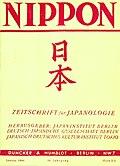Japan Institute Berlin
The Japan Institute in Berlin was at the suggestion of the former ambassador to Japan, Wilhelm Solf , supported by Fritz Haber , on May 8, 1925 in Berlin as "Institute of mutual knowledge of the spiritual life and public institutions in Germany and Japan (Japan Institute) e. V. ”and opened in December 1926 with the support of Adolf von Harnack in the rooms of the Kaiser Wilhelm Society in the Berlin Palace. It was the first independent Japanese institute in the western world.
The tasks
Specified in § 2 as follows: "The purpose of the institute is primarily to be achieved in the following way:
- by promoting all specialist sciences related to Japan,
- through publications by the institute,
- by showing suitable literature to interested parties,
- by translating this literature,
- by providing personal information.
Any political and economic activity is excluded. "
The Institute
The maintenance of the institute was financed by the German Reich. The institute was headed by a Japanese, Kuroda Genji until 1934 , and a German, until 1930 the Japan expert FM Trautz . A large library with books in Japanese and European languages was available to the general public.
A parallel institute was founded by the Japanese government in Tōkyō in 1927. Together with this, the Japan Institute published the magazine “Nippon. Journal of Japanese Studies ” . The magazine was published by Duncker & Humblot, Berlin.
In 1931 the institute had to move out of the city palace because the rooms were needed for other purposes. It found new rooms in house Kurfürstenstrasse 55 and thus came into the neighborhood of the Japanese embassy and the German-Japanese society, both of which had their headquarters in the nearby Ahornstrasse. In 1938 the company moved again to Brückenallee 10.
Tomoeda Takahiko was the Japanese director from 1934, and Araki Mitsutarō took over the Japanese management from 1938 to 1939 . Haber had worked as founding president on the German side, but was replaced by Solf in 1929. After his death, Admiral Paul Behncke (1866–1937) followed, then Admiral Richard Foerster (1879–1952). Martin Ramming , who was previously responsible for the library, acted as director of the institute from 1934 until it was dissolved in 1945.
When Hitler came to power in 1933, there was a gradual change in the focus of work. On the Japanese side, allegiance to the Kaiser was sworn, which on the German side was transferred to Hitler.
With the end of the Second World War , the institute stopped its work. Parts of the library came to the Japanese Department of the University of Bochum via the “West German Library” in Marburg .
Publications (selection)
- Tsudzumi Tsuneyoshi: The Art of Japan. Insel-Verlag Leipzig, 1929.
- Kanokogi Kazunobu :: The Spirit of Japan. Asia Major XVI, 1930.
- Siebold, Philipp Fran from: Nippon. Complete reprint of the original edition. Ernst Wasmuth 1930, 1931.
- Ramming, Martin: Travel of shipwrecked Japanese in the 18th century. Würfel-Verlag, 1931.
- Schepers, Hansjulius: Japan's sea fishery; an economic and geographical summary. F.Hirt, 1935.
- Tsudzumi Tsuneyoshi: The Art of Japan (1936).
- Tsudzumi Tsuneyoshi: Japan, the land of the gods. Insel-Verlag (1936).
- Kanekogi, Kazunobu The Spirit of Japan.
- Nachod, Oskar: History of Japan. (1936)
- Kitayama Junyu: West-East Encounter. Japan's culture and tradition. W. de Gruyter, 1941.
- Schwind, Martin: The design of Karafutos for Japanese space. Gothe: Justus Perthes, 1942.
- Nishida Kitarō: The Intelligible World. Translated by Robert Schinzinger. W. de Gruyter, 1943.
- Kitayama Junyu: Heroic Epic. The heroic in Japan. W. de Gruyter, 1944.
Remarks
- ↑ The "West German Library" housed the holdings of the former Prussian State Library until they were transferred to (West) Berlin to the newly built State Library there.
- ↑ Tsuzumi Tsuneyoshi (1887–1981) was a Japanese Germanist and translator.
- ↑ Kanekogi Kazunobu (鹿 子 木 員 信; 1884–1949) was a philosopher and naval officer. Politically, he belonged to the nationalist wing.
- ↑ Kitayama Jun'yu (北山 淳 友) lived from 1902 to 1962, most of the time in Germany and Czechoslovakia, where he died in Prague.
Individual evidence
literature
- Eberhard Friese: The Japan Institute in Berlin. In: Messages from OAG 139-142 (1986-87).
- Martin Ramming (Ed.): Japaninstitut eV In: Japan-Handbuch. Japanese studies reference book. Steiniger-Verlage Berlin, 1941.
